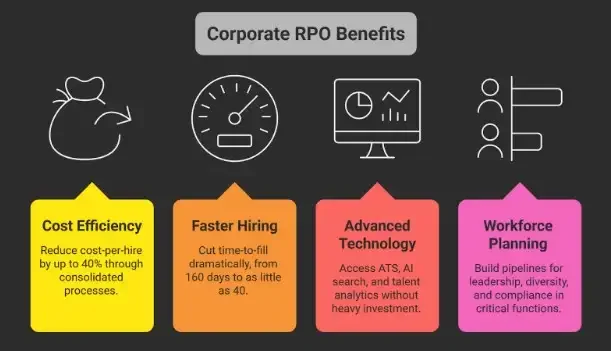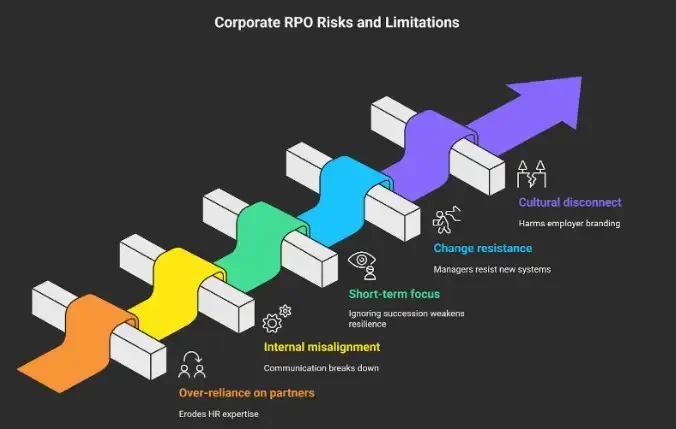Over-Reliance on External Partners
Placing too much responsibility on an RPO risks eroding your HR team’s expertise. When institutional knowledge leaves the company, flexibility suffers. HR leaders must own strategic workforce planning and retain control over final hiring choices, balancing external scale with internal authority.
Internal Misalignment
An RPO partnership involves multiple stakeholders, including HR executives, Talent Acquisition Managers, department heads, and occasionally, compliance officers. Without clear roles and responsibilities, miscommunication and delays are inevitable.
That’s why we advise you to conduct regular alignment meetings, make sure your reporting is transparent and based on shared KPIs that everyone agrees on. These steps avoid bottlenecks and keep everyone accountable to the same goals.
That brings us to the next point:
Short-Term Focus
Some RPO engagements emphasize speed and cost reduction as the main success metrics. While these are important, focusing only on them can weaken your workforce resilience over time.
That’s why you should demand strategies that address succession planning, leadership pipelines, and diversity goals. A provider with long-term planning built into its model ensures that efficiency today does not compromise your future readiness.
Change Resistance
Hiring managers used to old processes might resist new systems or workflows from an RPO. That hesitation can slow adoption and limit results.
Conversely, providers that offer clear training, process guides, and feedback support make the transition smoother and build lasting trust. That’s who you should partner with.
Pro Tip: Tech-driven hiring doesn’t have to feel like a disruption. In a recent project, Alpha Apex Group used multi-platform outreach to expand candidate reach by 3x, making adoption easier for hiring managers who saw immediate ROI from the new approach.
Cultural Disconnect
Every candidate interaction influences how your organization is perceived. If an RPO fails to reflect your values, tone, and expectations, the damage to employer branding can outweigh the gains in efficiency.
Leaders should evaluate how well a provider represents company culture during the selection phase. That evaluation includes reviewing sample candidate communications and employer branding initiatives.
Some mitigation strategies include:
Keep strategic oversight in-house, while using RPO for scale and efficiency.
Define KPIs that measure more than speed, including retention, candidate satisfaction, and internal mobility.
Involve hiring managers early to build trust and encourage smoother adoption of new processes.
Audit employer brand communications regularly to ensure cultural alignment.
A well-managed RPO can enhance your internal team. The right setup combines your partner’s scale and technology with your team’s ownership of culture, compliance, and strategic workforce planning.
RPO Is the Key to Accelerate Corporate Talent Acquisition
Corporate hiring grows more demanding every year. Compliance expands, candidate expectations rise, and traditional recruitment methods can’t keep up. RPO offers a strategic advantage, bringing the technology, expertise, and scalability needed to keep hiring efficient and future-ready.
When RPO becomes part of the company’s overall talent strategy, the results go beyond faster hiring. It gives organizations the flexibility to respond to changing markets while keeping long-term workforce planning and final decisions firmly in their hands.
At Alpha Apex Group, we partner with leaders to design tailored talent acquisition strategies that deliver measurable results.
To discuss how RPO can support your organization’s growth, connect with our team today.
FAQs
What Does Corporate Talent Acquisition Really Mean?
Corporate talent acquisition covers a coordinated talent ecosystem across the HR department and Recruitment Operations, designed to hire specialized roles at scale and align staffing with business goals. The goal is to build a sustainable candidate pool that supports future growth and executive leadership planning.
How is RPO Different from Regular Recruiting?
RPO providers bring enterprise-grade HR technology and talent acquisition software into a managed program that functions like an internal engine. They use AI-powered systems, predictive talent analytics, and structured sourcing methods such as Boolean strings to streamline hiring.
Unlike staffing agencies, RPO also supports diversity planning, compliance standards, and long-term workforce strategy.
What Role Does Technology Play in RPO?
Technology is central to RPO. From enterprise ATS, HR software, and AI-powered systems to candidate assessment, pre-employment assessment, and video interviews, providers use advanced recruitment technology that many organizations cannot manage internally.
These platforms improve accuracy, reduce the candidate drop-off rate, and give talent acquisition leaders stronger labor market insights.
Does RPO Work for Both Large Corporations and Smaller Companies?
Yes. Large enterprises rely on RPO for scale, compliance-heavy hiring, and remote recruiting from a larger talent pool. Meanwhile, mid-sized firms gain access to advanced tools like onboarding software, recruitment marketing ads, and structured interview questions.
Both can use RPO to build stronger pipelines, improve sourcing channel effectiveness, and compete in tight labor markets.
Can RPO Improve the Quality of Hires, Not Just Speed?
Absolutely. Quality of hire is a primary metric. Providers use skills-based hiring, candidate persona development, and thorough candidate screening to ensure long-term fit. They also align hiring with diversity and inclusion initiatives, use structured video interviewing, and integrate employee referrals.
This results in higher retention, stronger employee morale, and better performance outcomes after onboarding programs.
What Should I Watch Out for When Choosing an RPO Partner?
Look beyond capacity. Evaluate their expertise with specialized roles, their ability to mirror your employer brand, and if they support compliance and risk management. Also assess if they track metrics beyond time-to-hire, such as the quality of your employee retention strategies, talent acquisition spending, and sourcing channel effectiveness.



